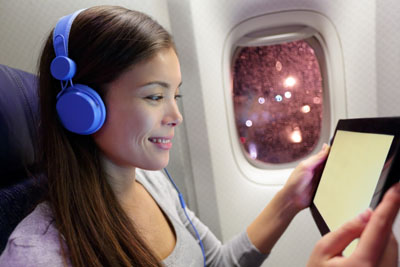 Recently, Ryanair – the Europe’s largest low-cost airline, operating around 1 600 flights daily – announced, it’s considering offering streamed entertainment and Wi-Fi access for its passengers free of charge. If the trials prove popular, the service could be rolled out to its entire fleet of around 300 Boeing aircraft. Moreover, in October 2014, United Airlines also announced plans to roll out Wi-Fi to its fleet of over 200 regional jets, delivering download speed of up to 9.8 Mbps. In the meantime, however, as Wi-Fi quickly turns into a major battleground in the quest to attract passengers, it may bring about some changes in the MRO segment as well.
Recently, Ryanair – the Europe’s largest low-cost airline, operating around 1 600 flights daily – announced, it’s considering offering streamed entertainment and Wi-Fi access for its passengers free of charge. If the trials prove popular, the service could be rolled out to its entire fleet of around 300 Boeing aircraft. Moreover, in October 2014, United Airlines also announced plans to roll out Wi-Fi to its fleet of over 200 regional jets, delivering download speed of up to 9.8 Mbps. In the meantime, however, as Wi-Fi quickly turns into a major battleground in the quest to attract passengers, it may bring about some changes in the MRO segment as well.
By now, having in-flight Wi-Fi on board the planes isn’t new. Many airlines already offer the service on selected routes, while some – like Virgin America – even have Wi-Fi on every plane. In the meantime, the demand for such solutions is growing rapidly. In fact, a The Honeywell Aerospace Wireless Connectivity Survey recently found that as much as 85% of 1 000 respondents in the US would use on board Wi-Fi if it were free. The report also found that in-flight Wi-Fi availability influences flight selection for over 60% of travellers, while more than a fifth saying they have paid more for their ticket in order to fly on an aircraft equipped with Wi-Fi. However, the newest ambitions of the carriers are not only to let passengers surf the Web or check email, but to provide Wi-Fi service fast enough to stream entertainment directly to personal electronics like smartphones, tablets, and computers.
“IFE systems are currently one of the key considerations for investors within the industry. The thing is, the rate at which IFE systems develop in today’s commercial aviation  market often means that a system installed on an aircraft today will be obsolete by the time the aircraft returns from a lease, and therefore may not be useful or desirable to the next operator. From this point of view, Wi-Fi-enabled entertainment systems may become a real game changer,” shares Kestutis Volungevicius, Head of Engineering and Training at FL Technics. “As more and more airlines are seeing that the flying public are making decisions based on their ability to have connectivity, it may well be expected that the demand for installation of such services will only rise in the upcoming years.”
market often means that a system installed on an aircraft today will be obsolete by the time the aircraft returns from a lease, and therefore may not be useful or desirable to the next operator. From this point of view, Wi-Fi-enabled entertainment systems may become a real game changer,” shares Kestutis Volungevicius, Head of Engineering and Training at FL Technics. “As more and more airlines are seeing that the flying public are making decisions based on their ability to have connectivity, it may well be expected that the demand for installation of such services will only rise in the upcoming years.”
According to Kestutis Volungevicius, Wi-Fi service not only provides a new source of revenue, but also allows the airline to quickly roll out in-flight entertainment into planes that normally aren’t outfitted with seat-back IFE monitors. Such systems often require expensive, laborious installations and require planes to be taken out of service for some time, but on smaller jets, space and weight are also an issue. Having an IFE system that uses Wi-Fi not only saves the airline from having to install and maintain monitors in planes, but saves money on fuel while potentially making more money from customers.
Several airlines, such as American Airlines, Japan Airlines, U.S. Airways, and Singapore’s Scoot, are already using such systems, which are easy to maintain and upgrade using USB flash drives. Moreover, Wi-Fi and personal device entertainment aren’t just relegated to regional jets. For instance, United has already started implementing them in its larger mainline planes, offering uninterrupted service even on international flights that fly over water. Eventually, United could turn away from expensive installations of seat-back monitors altogether, and rely solely on Wi-Fi streaming to personal devices.
“Airlines typically try to make the most of their aircraft by investing into interior refurbishment works in order to raise the comfort standards to modern levels. Needless to say, the demand for the implementation of on-board entertainment systems and Wi-Fi systems changes the workload as well as requirements for the MRO providers accordingly. For instance, it is clear that following the latest development trends, the already multiple staff training issues will only keep piling up.” says Kestutis Volungevicius, Head of Engineering and Training at FL Technics. “However, the providers can do nothing but try to adapt, as it seems that seat-back monitors may in fact become a thing of the past. As a result, the consumers might need to start learning the acronym BYOD – bring your own device – if they want to access a plane’s personal device entertainment service.”





